From Car Parks to Culture Parks
INTRODUCTION
Our studio explores the statement, ‘Away with the Cars, towards life-centred cities’. The following study explores a new form of urbanism that can take over the Barcelona Car Parks. Cars can be broadly viewed as a social system. And like all systems, they need supporting infrastructure. Unfortunately, this car infrastructure comes at a cost for cities. At the cost of other mobility infrastructure, other environmental infrastructure and other cultural infrastructure. These deficiencies can be actively replenished by repurposing the infrastructure exclusively serving private automobiles into cultural hubs for their respective neighbourhoods. A reflection of policies in Barcelona shows that the city is actively trying to integrate spaces for two distinct stakeholders: Children and the Elderly. Both these groups are currently marginalized due to the very nature of car infrastructure. These are the stakeholders that we selected to evaluate strategies that the city can develop for the reuse of parking infrastructure into civic infrastructure.
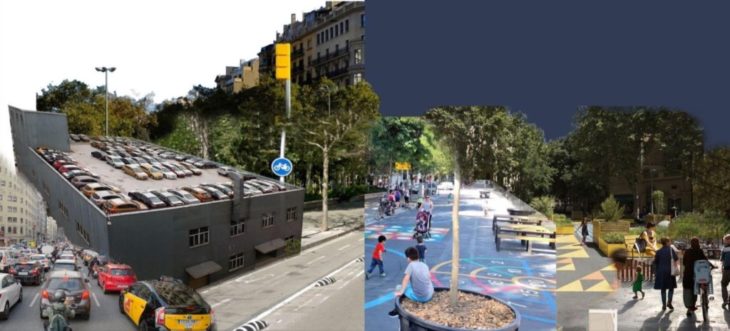
MAPPING INFRASTRUCTURE EXCLUSIVELY SERVING PRIVATE AUTOMOBILES
Our initial research tells us that in Barcelona there are 361 cars between every 1000 inhabitants. The car dependency of this city isn’t that high. Given that we remove our dependencies on cars. We started mapping the existing car parks within the city and cataloguing them into typologies. Barcelona has 77% underground parking, 13% surface parking and 10% multi-storey parking. 
MAPPING SPACES EXCLUSIVELY SERVING KIDS AND THE ELDERLY IN BARCELONA
Barcelona hosts a variety of spaces for all children of all age groups. Its urban environment caters to different needs for children as they grow up. It provides them with a variety of experiences and places to enjoy making them no less a part of the city than adults. These activities and functions make them feel that they are a part of the city because the city offers them a variety of things. The same is true for the elderly. An overlay of all these functions, at the city level helps us identify a site with high concentration of all these functions along with a high concentration of car-parks.
SITE SELECTION: MULTI-STOREY PARKING, CARRER DE RIPOLL, GOTHIC QUARTER
The Gothic Quarters are always filled with people, performances and festivals. It always has a great energy and pace attracting a diverse bunch of people, a lot of children too, visiting with their parents, strolling, playing with friends, or just being carried around by parents, throughout the year. The Neighbourhood is a dense urban fabric with an open plaza. Children are found with their parents in the city centre and mostly left free in the plaza where parents can keep an eye on them. Moreover, parents are constantly looking for areas that are defined by some kind of border or physical boundary, which allows children to move around on their own whilst offering parents a sense of safety. The elderly come here often for the church services.
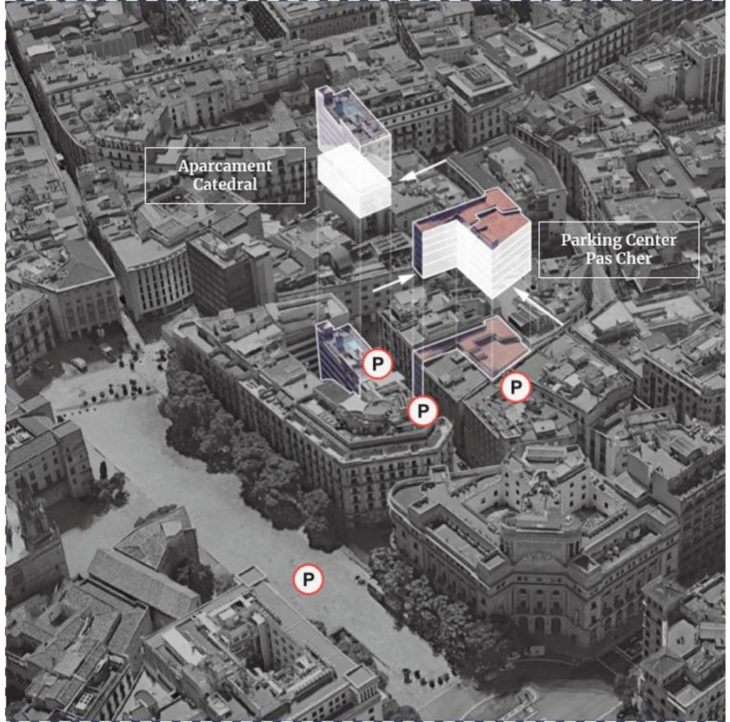
The site has 3 separate parking lots with entrances in the proximity of 50m (one of them being partially abandoned) and one a big underground parking lot. Currently, the parking infrastructure in this area is rapidly becoming obsolete while occupying extremely valuable spaces in the heart of the city. The car park we identified to repurpose, is in one of the inner streets surrounded by other public and private functions, it is a multi-storey parking lot with a built up area of 400 square meters. A Multi-storey parking, typologically speaking is a great structure to repurpose. The existing ramps work as mobility drivers, the roof can be made accessible to the public, light wells can be integrated to create courtyards and the service areas could still be retained. Moreover, it is the least used parking typology in Barcelona, making it easy to take them away first.
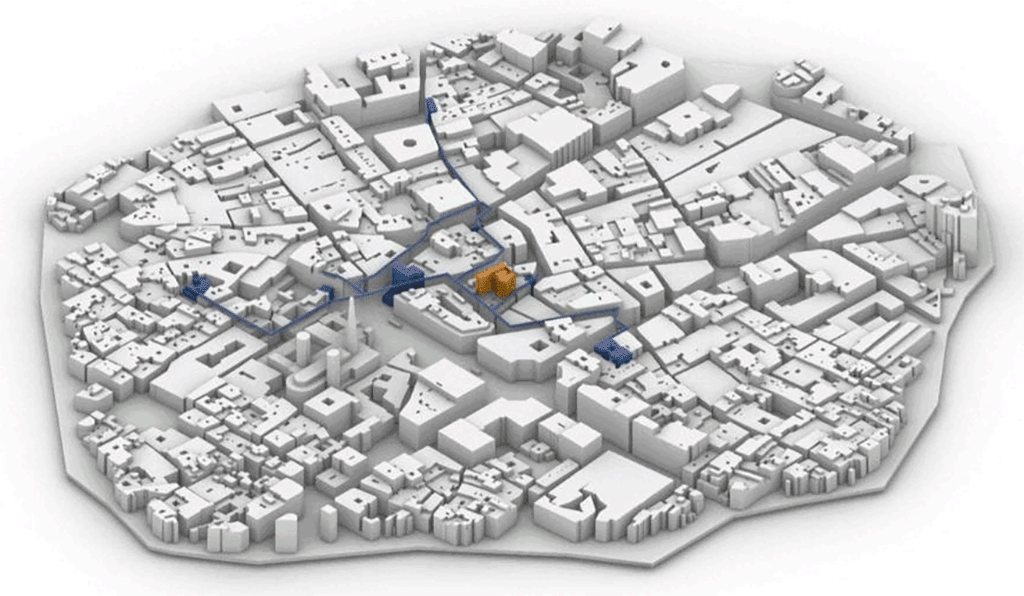
DESIGN STRATEGY: CENTER PAS CHER
The architectural language is developed as a result of user movement, site massing and composition of the form. Plot divisions, accessibility and functions give an order to aesthetics and design. The massing itself is a response to the urban fabric. It is an attempt to play with surfaces that integrate seamlessly into one another and the streetscape. The urban form generated as a result of design development addresses the notion of play at varying thresholds. It imbibes the childlike wonder of being in spaces, exaggerated through modelling of masses, portals and thresholds in accordance to user experience that looks at users to develop their own navigation system based on the order the repurposed form adopts. It is an attempt to curate scales such that it creates a paradigm shift in the way we look at Barcelona’s urban fabric.
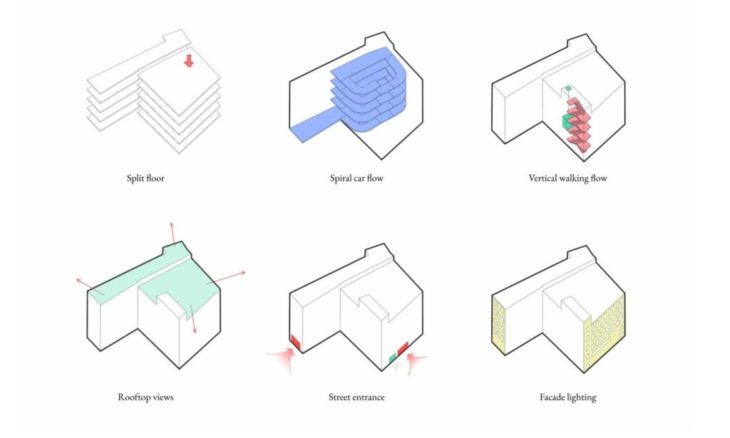
The arrangement of different spaces and the varied functions around the playscape initiates the place to run throughout the day. This is essential because this will keep the urban form and its surrounding occupied throughout the day and will encourage and initiate play sideways. The idea is to design an urban form at the heart of the city that is integrated with the idea of play. Here play is viewed as action with architecture as its support. The playscape tries to manifest it through spaces. The attempt is to create a new sense of urbanism amidst the city center, one that is more inclusive and active in its approach and management of users, that provides breakout spaces at varying scales and forms to develop niches that can best activate the structure in terms of aesthetics and functionality. There is a careful consideration given to threshold treatments and their engagement with the user is particularly curated to create memorable experiences through exaggeration of scale and modelled features such as the ramp, the roof and the openings.
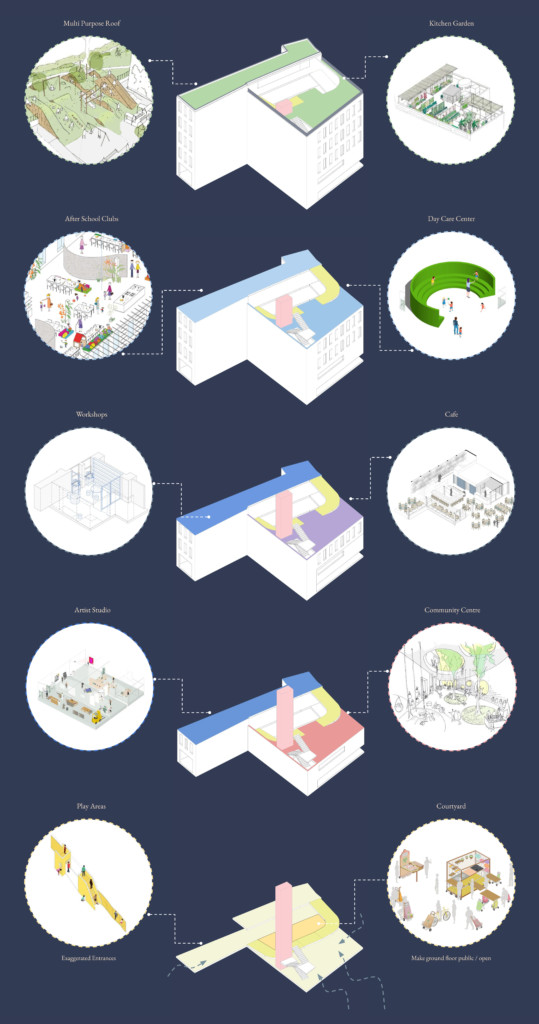
FROM CAR PARKS TO CULTURE PARKS
The next part of our study involved exploring similar multi-storey car parking’s across Barcelona that could benefit from our strategy of creating cultural parks for the neighbourhood. Evolved from the earlier mapping of all car-parks typologically, we filtered the data to visualize all multi-storey parking’s with less than 400 square meters of build up area. This allowed us to obtain 10 distinct multi-storey car-parks. These car parks were visualized along with a 10 minute walking zone around them which represents their neighbourhood that the infrastructure is currently serving. These 10 structures become our base to develop a holistic strategy of repurposing car-parks into culture-parks. Conversely, we built a processing tool to help us curate demographic understandings into purposeful transformation.
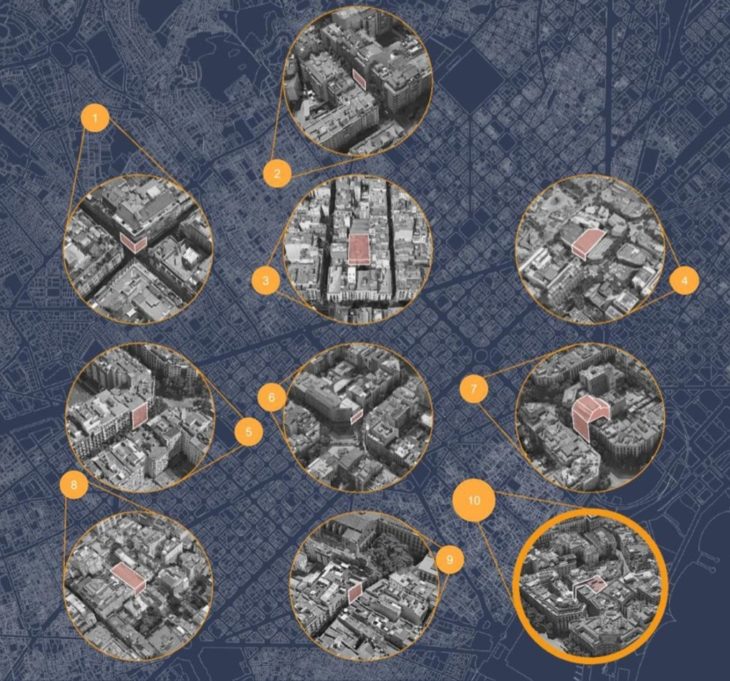
This analysis helps us understand the stakeholders we need to deal with and identify potential neighbourhoods with specific car parks which meet the conditions we need to execute our repurposing strategies. Conversely, studying the datasets helps us further analyse the demographics that we have classified (Children and the elderly) and specialize the growing needs and aspirations of these citizens through better understanding the cultural fabric of a neighbourhood. With knowledge of accurate representations of the two stakeholders from each neighbourhood, we can better identify, what percent of the repurposed space should be allocated for which use.

The study and the consequent processing tool building exercise culminates in the creation of what we call the, ‘Parking Conversion Compass’. This compass factors in all the possible functions which we envision best for children and(or)elderly and presents to us the analysis of the number of each of these spaces within 10-minute walking distance from specific parking lots and plots them against the number of children and the elderly within that neighbourhood. As part of our repurposing strategy for multi storey car-park infrastructure, it became extremely important to understand the demographic within specific neighbourhoods and the existing functional spaces for the same demographic. The Parking Conversion Compass analyses and illustrates the need for specific functions, provides a catalogue of existing spaces that could support such developments, whilst accounting for the demography that will eventually benefit from and shape the repurposing of the identified multi storey car-parks.
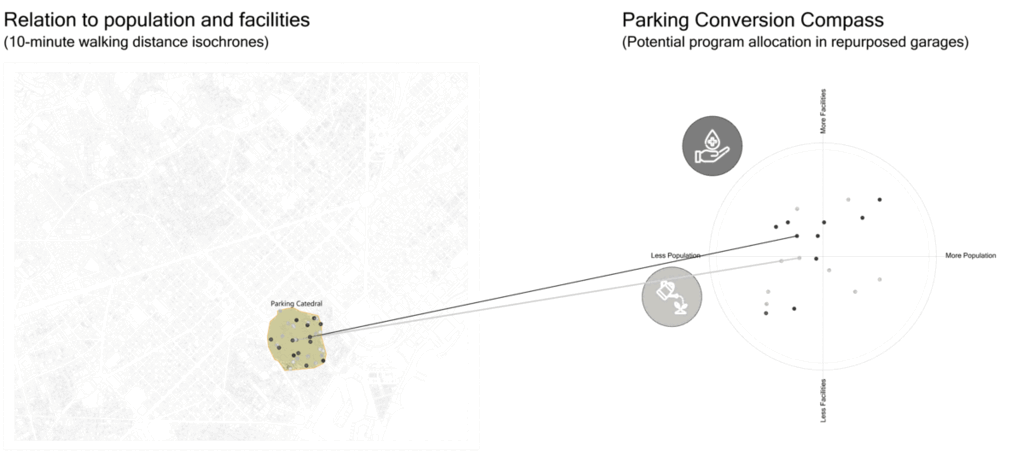
Each cultural park can be distinguished by historic resources and land related to such resources and which constitutes an interpretive, educational, and recreational resource for the public at large. The project aims to empower citizens and visitors to claim the park as their very own. Multiple disciplines/institutes can be designed to be linked and housed in a transdisciplinary fashion, to enlarge the dimensions of ‘play’ within the city, for children and adults alike. Cultural parks can take different meanings depending on the disciplinary root of the user who is experiencing them. They can be simultaneously spatial planning instruments, cultural heritage stewards or vectors for tourism attraction. In parallel, cultural parks can be articulated differently at the local level depending on who plans and supports them, with which objectives and in what context.
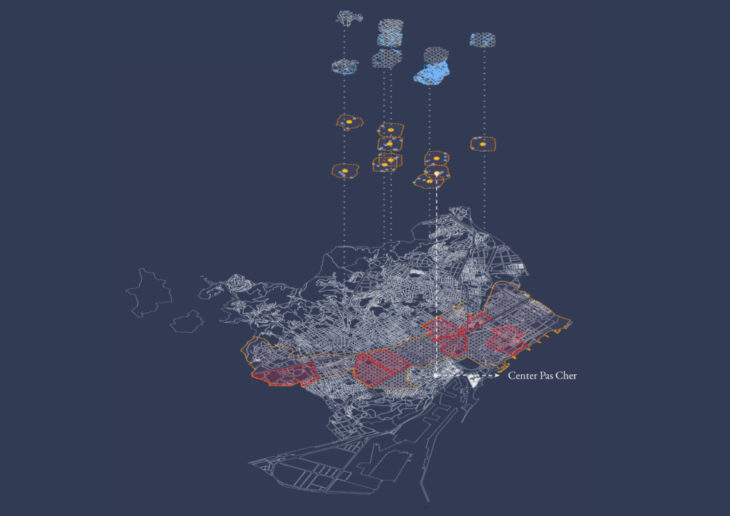
These cultural parks can be manifested as positive and constructive tools whose performance is associated with the preservation of heritage, the overcoming of the nature/culture divide, the reinforcing of identity and memory of neighbourhoods and the strengthening social cohesion and economic development.
DATA SOURCES
Open Data BCN
REFERENCES
1 – Open Data BCN – Ajuntament de Barcelona’s open data service. (2021). Retrieved 24 November 2021, from: https ://opendata-ajuntament.barcelona.cat/en
2 – Gencat – Information, procedures and services of the Government of Catalonia – Census Section. (2021). Retrieved 24 November 2021, from : https ://www.icgc.cat/es/Administracion-y-empresa/Descargas/Capas-de-geoinformacion/Secciones-censales
‘From Car Parks to Culture Parks’ is a project of IAAC, Institute for Advanced Architecture of Catalonia developed in the Master in City & Technology 2021/22 by Students: Gayatri Agrawal, Parshav Sheth, Robert Yussef, Can Xu and Faculty: Eduardo Rico, Mathilde Marengo and Iacopo Neri